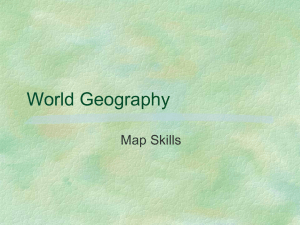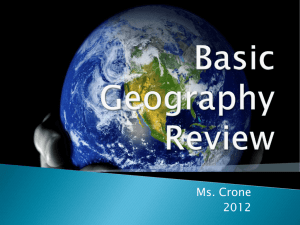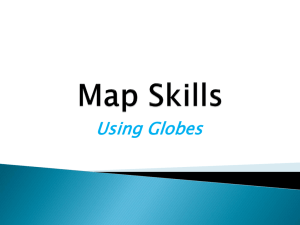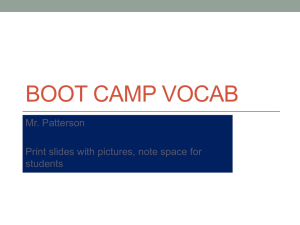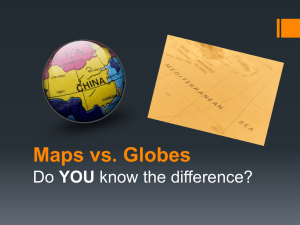outline notes slide 52-55
advertisement
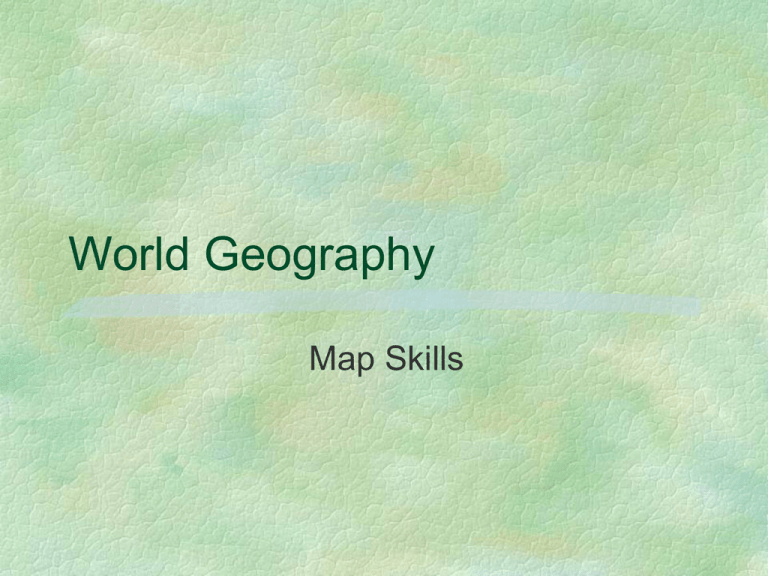
World Geography Map Skills Maps ●A map is a flat diagram of all or parts of Earth’s surface. Map Essentials ●A map’s title show what the subject of the map is. The map title is usually the first thing you should look at when studying a map, because it tells you what the map is trying to show. ●A compass rose has arrows that point to all four principal directions (North, South, East, and West) ●Mapmakers use scales to represent the distances between points on a map. Scales give the distance in miles and kilometers. oTo find the distance between two points on the map, place a piece of paper so that the edge connects the two points. Mark the location of each point on the paper with a line or dot. Then compare the distance between the two dots with the map’s scale. ●The legend, or key, explains what the symbols on the map represent. Legends may use specific symbols or colors to represent information on maps. ●A locator map shows where in the world the area on the map is located. Globe ●A globe is a scale model of the Earth. It is useful for showing the entire Earth or studying large areas of Earth’s surface. Lines of Latitude and Longitude ●To study the world, geographers use a pattern of imaginary lines that circles the globe in east-west and north-south directions. It is called a grid. The intersection of these imaginary lines helps us find places on Earth. ●The east-west lines in the grid are lines of latitude. They measure distance north and south of the equator. ●Lines of latitudes are called parallels. ●Parallels north of the equator are labeled with an N ●Parallels south of the equator are ●The equator in an imaginary lines that circles the globe halfway between the North and South Poles. ●Parallels measure distance from the equator in degrees. The symbol for degree is ° ●Degrees are further divided into minutes. There are 60 minutes in a ●The north-south imaginary lines are lines of longitude. ●Lines of longitude are called meridians. These imaginary lines pass through the poles. The measure distance east and west of the prime meridian. ●The prime meridian is an imaginary line that runs through Greenwich, England. It represents ●Lines of latitude range from 0°, for locations on the equator, to 90°N or 90°S, for locations at the poles. ●Lines of longitude range from 0° on the prime meridian to 180° on a meridian in the mid-Pacific Ocean. ●Meridians west of the prime meridian to 180° are labeled with a W. ●Those eat of the prime meridian to 180° are labeled with an E. Why do we use grids? ●To identify the exact location of any place on Earth. oO.S.E.S is located at 36°02´31.9 "N 84°20´42.10 "W Types of Maps ●Political Maps show the major political features of a region. These features include country borders, capital cities, and other places. ●Physical maps show the major physical features of a region. These features may include mountain ranges, rivers, oceans, islands, deserts, and plains. ●Special-Purpose maps focus on one special topic such as resources, population, or time zone. These maps present information on the topic as it relates to a region. ●Historical maps show a variety of information of past events. Contour Map Shows elevation more exactly using lines on the map that join all the places that have the same elevation. (looks like a fingerprint) Contour Map Continents The world is divided into 7 continents. You will need to be able to locate and label them on a map along with geographic characteristics; Africa, Antarctica, Asia, Australia, Europe, North America, South America North America Canada, United States, Mexico North America Central America (still part of North America): Guatemala, Belize, El Salvador, Honduras, Nicaragua, Costa Rica, Panama North America Caribbean (still part of North America): Anguilla, Antigua, Aruba, Barbados, Cayman Islands, Dominica, Grenada, Guadalupe, Martinique, Montserrat, Netherlands Antilles, Puerto Rico?, St. Kitts & Nevis, St. Lucia, St. Vincent & Grenadines, Turks & Caicos, Virgin Islands, Cuba, Bahamas, Dominican Republic, Haiti, Jamaica, Trinidad & Tobago Country Project: Country Project: You will be randomly given a country. Once the state is selected you will research characteristics of that country. Example Characteristics: What is the history of the country? How has this evolved? What is the standard of living? How do people earn a living/what is the economy based on? What are the important geographic considerations in your country? Who are notable residents of the country? What is the current political climate? (how stable is the country? When did they have a revolution etc?) Countries: Country Project: You will turn in a written report on your country (1-2 pages). You will also make your state presentations on September 22th. The project will have 2 separate grades – one for the written portion – one for the presentation Today we will be assigned our countries and work on initial research. – you will be given some class time each day for the next two weeks Countries Project: Timeline: September 3 – pick country and get as much initial information as possible September 5th – continue with research/begin organization of material September 8th – turn in outline of both written report and oral presentation REGIONS OF THE UNITED STATES: Timeline: September 11th (rough draft of report is due) September 15th (rough drafts will be returned with feedback) September 21st country report is due along with presentation Go to www.quia.com/pages/jchristman38/page28 click on the geolocator The first location that you are given a picture of is the location that you will do your report on. REGIONS OF THE UNITED STATES: Midwest Geography: The Great Lakes are vitally important to the Midwest: (ocean access) REGIONS OF THE UNITED STATES: Influence of the Great Lakes: iron ore mining (from Northern Minnesota – was shipped to southern Lake Michigan (to be turned into steel) and Michigan/Ohio (to be turned into automobiles) REGIONS OF THE UNITED STATES: Mississippi River: Has provided access and exchange for cultural ideas of the Midwest to flow down river as well as the influence of the South to flow up river (think Jazz/Blues which both have roots in the Lower Mississippi River Delta REGIONS OF THE UNITED STATES: Mississippi River: the most important river in the United States as it provides port (access to the oceans) for the region from the Rocky Mountains to the Appalachian Mountains The Mississippi River has very strongly influenced cultural exchange up and down the River – think the influence of the Blues and of Jazz (both from the southern Mississippi River Delta REGIONS OF THE UNITED STATES: Major Midwestern Cities: Chicago, Detroit, Cleveland, Minneapolis/St . Paul, Kansas City, St. Louis, Indianapolis, Cincinnati REGIONS OF THE UNITED STATES: Northeast: the most populous region of the United States – also the wealthiest region of the United States Includes the states of: Maine, New Hampshire, Vermont, Massachusetts, New York, Rhode Island, Connecticut, Pennsylvania, New Jersey, Delaware, Maryland REGIONS OF THE UNITED STATES: Northeast: the economic activity of the region is comprised of mainly trade with Europe and the financial services sector (banks, brokerage houses, stock market, etc.) New York City is the major city in the region (we will look at others also but NYC deserves special mention) It is the financial services headquarters of the world Outline 7th grade outlines are due at the end of class – eighth grade outlines are due at the beginning of class on Tuesday ! ! ! Format: The title of your project (this could be as simple as the name of the place you are researching or feel free to get much more creative: Introduction: How are you going to introduce your project? What are strategies that good writers use to introduce material? (you do not need to write the introduction here but you should include the idea of what the introduction will consist of Outline Format Body paragraph 1: What is the first topic that you are going to write about? It should be one of the more interesting things you found – this along with the introduction capture the readers/listeners interest Body paragraph 2: This will be where you include some of the more factual but perhaps less interesting elements of the research – a lot of young writers struggle here as the information still needs to flow Outline Format Body paragraph 3 (might not actually be the 3rd paragraph) this is a great time to transition away from historical information to more contemporary (present day) information Conclusion: This will be the lasting impression that you leave on the reader – this along with the introduction need to be the strongest pieces of writing/the best part of the presentation Outline Appearance: I. Introduction II. Main idea or more interesting information a. A story about an important event or person b. Transition sentence to the most information dense portion of the paper III. Informational piece (organization of this section is vital) a. Piece of information 1 b. Piece of information 2 c. Piece of information 3 etc IV. Modern information (move away from the historical into the present (follow format from step III V. Conclusion
